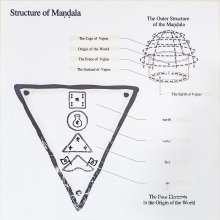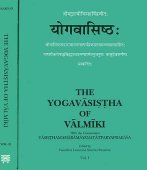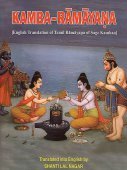Drishya, Dṛśya: 21 definitions
Introduction:
Drishya means something in Hinduism, Sanskrit, Marathi, Hindi. If you want to know the exact meaning, history, etymology or English translation of this term then check out the descriptions on this page. Add your comment or reference to a book if you want to contribute to this summary article.
The Sanskrit term Dṛśya can be transliterated into English as Drsya or Drishya, using the IAST transliteration scheme (?).
Alternative spellings of this word include Drashy.
Images (photo gallery)
In Hinduism
Vedanta (school of philosophy)
Source: Google Books: Studies on the MoksopayaDṛśya (दृश्य) refers to “perceived objects”, according to the 10th century Mokṣopāya or Mokṣopāyaśāstra 6.182.13-17.—Accordingly, “With regard to each of [the three:] perceiver (draṣṭṛ), perception (darśana) and perceived objects (dṛśya), the state of mere knowledge [i.e., bodhamātra] is the essence; therefore there is not in the least a difference from it (i.e. knowledge), like a flower in space (is not different from space). (13) What is of the same kind becomes one. Therefore mutual perception [of things] determines their unity. (14) If wood, stones and other [material objects] did not have knowledge as their nature, then there would be a permanent nonperception of these, which would even be nonexistent. (15) When the whole beauty of perceptible objects has but one form of mere knowledge, then, whether it is different or identical, it becomes known through knowledge. (16) This whole [group of] perceptible objects in the world has expanded [as] mere knowledge, just as wind is mere movement and the ocean mere water. (17)”.
Source: ORA: Amanaska (king of all yogas): (Advaita Vedanta)Dṛśya (दृश्य) refers to the “visible object (of the mind)”, according to the Māṇḍūkyopaniṣatkārikā 3.31-32.—Accordingly, while discussing duality and mental activity: “All this duality which is [comprising of] whatever is moving and motionless is [just] a visible object of the mind (manas-dṛśya). For when [the state of] no-mind of mind [arises], duality is not perceived. [Why is this?] When the mind does not conceptualize because [one has] realized the truth of the self, then, it goes to the state of no mind. Therefore, in the absence of perceivable objects, there is no perception [of duality]”.

Vedanta (वेदान्त, vedānta) refers to a school of orthodox Hindu philosophy (astika), drawing its subject-matter from the Upanishads. There are a number of sub-schools of Vedanta, however all of them expound on the basic teaching of the ultimate reality (brahman) and liberation (moksha) of the individual soul (atman).
Shaiva philosophy
Source: Brill: Śaivism and the Tantric Traditions (philosophy)Dṛśya (दृश्य) refers to “(that which is) perceptible”, according to the Viṃśikāvṛtti 7.—Accordingly, “So no lump [of matter] at all should be perceptible (dṛśya); for the atoms cannot be in contact [with each other] at all, since they have no parts”.
-
Shaktism (Shakta philosophy)
Source: Google Books: ManthanabhairavatantramDṛśya (दृश्य) refers to “(whatever is) visible” (to embodied beings), according to the Kularatnapañcakāvatāra verse 1.23cd-33ab.—Accordingly, “[...] Whatever is visible or invisible (dṛśya-adṛśya) to embodied beings in the three worlds is all, O goddess, certainly Kaula, the cause of union (with the absolute). O goddess, the ten-fold divine source (of phenomena, that is, the above nine and Kaula) is the fourfold womb (of the four kinds of living beings). They arise and dissolve away in Kaula. (All that) moves and is immobile, the triple world with (all) that moves and does not is born from Kula and comes from Akula. O beloved, that is said to be Kaula”.

Shakta (शाक्त, śākta) or Shaktism (śāktism) represents a tradition of Hinduism where the Goddess (Devi) is revered and worshipped. Shakta literature includes a range of scriptures, including various Agamas and Tantras, although its roots may be traced back to the Vedas.
Ganitashastra (Mathematics and Algebra)
Source: archive.org: Hindu MathematicsDṛśya (दृश्य, “visible”) refers to the “absolute”, according to the principles of Bījagaṇita (“algebra” or ‘science of calculation’), according to Gaṇita-śāstra, ancient Indian mathematics and astronomy.—In the Bakhshali treatise the absolute term is called dṛśya (visible). In later Hindu algebras it has been replaced by a closely allied term rūpa (appearance), though it continued to be employed in treatises on arithmetic. Thus the true significance of the Hindu name for the absolute term in an algebraic equation is obvious. It represents the visible or known portion of the equation while its other part is practically invisible or unknown.

Ganita (गणित) or Ganitashastra refers to the ancient Indian science of mathematics, algebra, number theory, arithmetic, etc. Closely allied with astronomy, both were commonly taught and studied in universities, even since the 1st millennium BCE. Ganita-shastra also includes ritualistic math-books such as the Shulba-sutras.
Kavyashastra (science of poetry)
Source: Shodhganga: Elements of Art and Architecture in the Trtiyakhanda of the Visnudharmottarapurana (kavya)Dṛśya (दृश्य) or Dṛśyakāvya refers to one of the two types of Kāvya (“poetry”), according to the Sāhityadarpaṇa.—There are two broad divisions of kāvya (poetry) viz., dṛśya-kāvya and śravya-kāvya.

Kavyashastra (काव्यशास्त्र, kāvyaśāstra) refers to the ancient Indian tradition of poetry (kavya). Canonical literature (shastra) of the includes encyclopedic manuals dealing with prosody, rhetoric and various other guidelines serving to teach the poet how to compose literature.
Yoga (school of philosophy)
Source: ORA: Amanaska (king of all yogas): A Critical Edition and Annotated Translation by Jason BirchDṛśya (दृश्य) refers to “seeing” (e.g., “that which the Yogin sees”), according to the Amanaska Yoga treatise dealing with meditation, absorption, yogic powers and liberation.—Accordingly, as Īśvara says to Vāmadeva: “[...] That which [the Yogin] sees (dṛśya) is gradually extinguished even as he looks at it, and also what he smells as he smells it, what he tastes as he tastes it, the agreeable sounding sounds as he hears them and what he touches as he touches it, and so also in due course the mind, like a flame without fuel, of the true Yogin who has reached the domain of the reality of that state which is called Non-duality. [...]”.

Yoga is originally considered a branch of Hindu philosophy (astika), but both ancient and modern Yoga combine the physical, mental and spiritual. Yoga teaches various physical techniques also known as āsanas (postures), used for various purposes (eg., meditation, contemplation, relaxation).
General definition (in Hinduism)
Source: Wisdom Library: HinduismDṛśya (the object) and draṣṭṛ (the subject) are terms used in the Hindu philosophy of Vedānta, as explained in the Brahma-kāṇḍa by Maṇḍana according to his own view.
Languages of India and abroad
Marathi-English dictionary
Source: DDSA: The Molesworth Marathi and English Dictionarydṛśya (दृश्य).—a (S) To be seen, visible.
--- OR ---
dṛśya (दृश्य).—m S In arithmetic. A given number.
Source: DDSA: The Aryabhusan school dictionary, Marathi-Englishdṛśya (दृश्य).—a To be seen, visible.
Marathi is an Indo-European language having over 70 million native speakers people in (predominantly) Maharashtra India. Marathi, like many other Indo-Aryan languages, evolved from early forms of Prakrit, which itself is a subset of Sanskrit, one of the most ancient languages of the world.
Sanskrit dictionary
Source: DDSA: The practical Sanskrit-English dictionaryDṛśya (दृश्य).—pot. p. [dṛś karmaṇi kyap]
1) To be seen, visible.
2) To be looked at.
3) Beautiful, pleasing to the sight, lovely; निदर्शयामास विशेषदृश्यम् (nidarśayāmāsa viśeṣadṛśyam) R.6.31; तमेकदृश्यं नयनैः पिबन्त्यः (tamekadṛśyaṃ nayanaiḥ pibantyaḥ) (nāryaḥ) Kumārasambhava 7.64.
-śyaḥ (Arith.) A given quantity or number.
-śyam A visible object; the visible world; दृश्यं तमसि न पश्यति दीपेन विना सचक्षुरपि (dṛśyaṃ tamasi na paśyati dīpena vinā sacakṣurapi) M.1.9.
Source: Cologne Digital Sanskrit Dictionaries: Shabda-Sagara Sanskrit-English DictionaryDṛśya (दृश्य).—mfn.
(-śyaḥ-śyā-śyaṃ) 1. Visible, to be seen. 2. Beautiful, pleasing. m.
(-śyaḥ) (In Arithmetic,) A given quantity or number. E. dṛś to see, kyap aff.
Source: Cologne Digital Sanskrit Dictionaries: Cappeller Sanskrit-English DictionaryDṛśya (दृश्य).—[adjective] to be seen, visible to ([instrumental] or —°); worth seeing, beautiful; [abstract] tā† [feminine], tva† [neuter]
Source: Cologne Digital Sanskrit Dictionaries: Monier-Williams Sanskrit-English Dictionary1) Dṛśya (दृश्य):—[from dṛś] 1. dṛśya mfn. visible, conspicuous, [Ṛg-veda; Mahābhārata; Kāvya literature] etc.
2) [v.s. ...] to be looked at, worth seeing, beautiful, pleasing, [Harivaṃśa; Kāvya literature; Purāṇa]
3) [v.s. ...] m. ([arithmetic]) a given quantity or number
4) [v.s. ...] n. any visible object, [Mālavikāgnimitra i, 9]
5) [v.s. ...] the visible world, [Religious Thought and Life in India 119]
6) [v.s. ...] Name of a town = -pura, [Brahma-purāṇa]
7) [from dṛś] 2. dṛśya ind. (for dṛṣṭvā) having seen, [Mahābhārata]
8) Dṛṣyā (दृष्या):—f. = dūṣyā, [cf. Lexicographers, esp. such as amarasiṃha, halāyudha, hemacandra, etc.]
Source: Cologne Digital Sanskrit Dictionaries: Yates Sanskrit-English DictionaryDṛśya (दृश्य):—[(śyaḥ-śyā-śyaṃ) a.] Visible. m. A given quantity or number.
Source: DDSA: Paia-sadda-mahannavo; a comprehensive Prakrit Hindi dictionary (S)Dṛśya (दृश्य) in the Sanskrit language is related to the Prakrit words: Dissa, Dessa, Pāsima.
[Sanskrit to German]
Sanskrit, also spelled संस्कृतम् (saṃskṛtam), is an ancient language of India commonly seen as the grandmother of the Indo-European language family (even English!). Closely allied with Prakrit and Pali, Sanskrit is more exhaustive in both grammar and terms and has the most extensive collection of literature in the world, greatly surpassing its sister-languages Greek and Latin.
Hindi dictionary
Source: DDSA: A practical Hindi-English dictionaryDṛśya (दृश्य) [Also spelled drashy]:—(nm) a scene; sight, spectacle, view; (a) visible, spectacular; —[ghaṭanā] a phenomenon; ~[lekha] a panorama; scenario; -[śrāvya] audiovisual.
...
Kannada-English dictionary
Source: Alar: Kannada-English corpusDṛśya (ದೃಶ್ಯ):—
1) [adjective] that can be seen; perceptible by the eye; visible.
2) [adjective] fit to be seen.
3) [adjective] pleasing to the eye; beautiful.
--- OR ---
Dṛśya (ದೃಶ್ಯ):—
1) [noun] that which is seen; sight.
2) [noun] the act of seeing.
3) [noun] that which is fit to be seen, watched.
4) [noun] (rhet.) a literary work that is or can be, presented dramatically (on a stage).
Kannada is a Dravidian language (as opposed to the Indo-European language family) mainly spoken in the southwestern region of India.
Nepali dictionary
Source: unoes: Nepali-English Dictionary1) Dṛśya (दृश्य):—n. 1. sight; scene; view; scenery; 2. picture; view; sketch; 3. scene;
2) Dṛśya (दृश्य):—adj. 1. to be seen; visible; evident; 2. worthy of being seen; beautiful; pleasing; 3. perceptible; phenomenal; 4. visual; optic;
Nepali is the primary language of the Nepalese people counting almost 20 million native speakers. The country of Nepal is situated in the Himalaya mountain range to the north of India.
See also (Relevant definitions)
Starts with: Drishyadrishya, Drishyajati, Drishyakavya, Drishyamana, Drishyamegha, Drishyamtara, Drishyapura, Drishyashravya, Drishyashravyatva, Drishyasthapita, Drishyata, Drishyate, Drishyati, Drishyatva, Drishyavali, Drishyavrishana, Drishyetara, Drishyojjhita.
Query error!
Full-text (+82): Adrishya, Drishyatva, Nadrishya, Drishyajati, Drishyata, Sudrishya, Drishyadrishya, Drishyapura, Drishyetara, Pratyakshadrishya, Samdrishya, Ekadrishya, Drishyakavya, Drishyashravya, Drishyasthapita, Manodrishya, Sukhadrishya, Gramya-drishya, Kudrishya, Visheshadrishya.
Relevant text
Search found 76 books and stories containing Drishya, Dṛśya, Drsya, Dṛṣyā; (plurals include: Drishyas, Dṛśyas, Drsyas, Dṛṣyās). You can also click to the full overview containing English textual excerpts. Below are direct links for the most relevant articles:
Garga Samhita (English) (by Danavir Goswami)
Verse 1.11.42 < [Chapter 11 - Description of Śrī Kṛṣṇacandra’s Birth]
Samkhya thoughts in the Mahabharata (by Shini M.V.)
Principles in Yoga Philosophy < [Chapter 3 - The Philosophical Tenets in the Śānti-parva]
Ganitatilaka (Sanskrit text and English introduction) (by H. R. Kapadia)
Page 129 < [Sanskrit Text of the Ganitatilaka]
Page 147 < [Sanskrit Text of the Ganitatilaka]
Page 138 < [Sanskrit Text of the Ganitatilaka]
Yoga-sutra with Bhashya Vivarana (study) (by Susmi Sabu)
The concept of Drastr (“the seer”) and Drsya (the seen) < [Chapter 4 - Textual Examination of the Text]
The concept of Kaivalya (liberation)—The final Goal < [Chapter 4 - Textual Examination of the Text]
The beginning of the Vivarana Text < [Chapter 4 - Textual Examination of the Text]
Malatimadhava (study) (by Jintu Moni Dutta)
Part 2a - Mālatīmādhava as a Prakaraṇa < [Chapter 1 - Introduction]
The backdrop of the Srikanthacarita and the Mankhakosa (by Dhrubajit Sarma)
Related products



